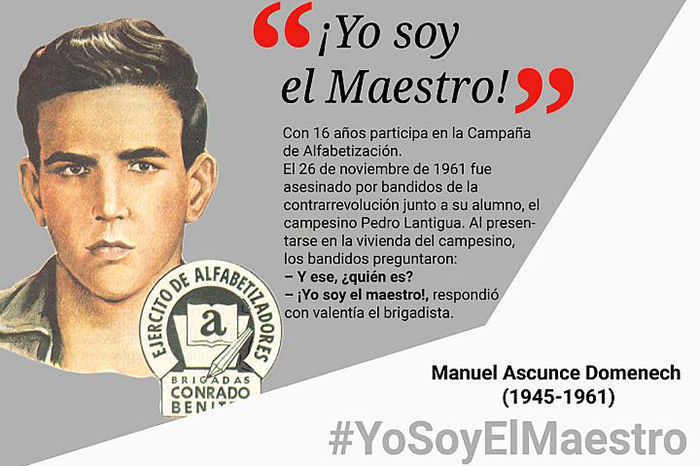
U.S.-funded rebel bands in rural Cuba were characterized by their extreme cruelty, as they showed on November 26, 1961 when they arrived at the hut of the peasant and militia member Pedro Lantigua in the Escambray Mountains, where the literacy teacher Manuel Ascunce Domenech was doing his duty.
According to witnesses, the assassins arrived in droves and shouting, “Where is the rope?” in order to frighten those present", but Lantigua tried to protect the teacher saying that he was a relative, since the bandits insisted on finding ‘the little communist teacher’. However, Ascunce responded: "I am the teacher!”
It was enough for those beasts to take both men away despite the pleading of the relatives. When their corpses were found the next day, they were shocked by the extent of the wounds, mutilations and blows that they suffered before being murdered.
The criminals, members of Julio Emilio Carretero's gang, were bent on killing ‘Manolito’, as Ascunce was affectionately known after just one week in Lantigua’s home. It was located in a dangerous area that was brimming with counterrevolutionary elements, but the young teacher had volunteered to be there in place of a female comrade whom he wanted to spare the risk and isolation.
Those who knew Ascunce hold that he stood out for being a mature, dependable and disciplined young man who shared everything he had with his friends or those in need anything and who reflected his early formation in the revolutionary values instilled in him by his parents.
In 1960, Cuba astonished the world when Fidel Castro announced at the UN General Assembly a project to eradicate illiteracy in Cuba by 1961, a task as far-reaching and short-termed as no other ever planned by any country.
Thus, while the UN and even UNESCO sympathized with and supported the promising program, in the United States the CIA set out to thwart the Cuban effort, calling it a sort of communist brainwashing plan, and they went beyond the smear campaigns to plot the murder of both the peasants who wanted to overcome ignorance and their literacy teachers.
By then, Yankee imperialism was backing hundreds of rebel bands, mainly in the Escambray region. Indeed, on January 5, 1961, they chose as their first victim the teacher Conrado Benitez. When they were capture, his own killers confessed that they promised him to spare him his life if he would relinquish his ideals, to which Conrado replied: "I am a revolutionary and will not betray my people". He was savagely tortured and killed, along with the peasant Eleodoro Rodriguez Linares (Erineo).
Far from deterring Cuban youth, the martyrdom of that 18-year-old young black man, to the frustration of his assassins and mentors from the North, inspired more than 100,000 of them to join a Brigade named after Conrado Benítez that brought to a successful end the Literacy Campaign in December 1961.
On December 22, 1961, Fidel Castro announced that more than 700,000 Cubans learned to read and write regardless of the obstacles posed by the United States and its internal agents, who failed in their attempt to prevent the triumph of the first historic campaign entrusted by the Revolution to the youth, from which Conrado Benítez and Manuel Ascunce Domenech, brothers in glory and martyrdom, emerged as symbols.
Sidebar

 Agencia Cubana de Noticias
Líder en información nacional
Agencia Cubana de Noticias
Líder en información nacional








Nos reservamos el derecho de no publicar los comentario que incumplan con las normas de este sitio